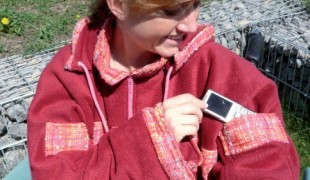- 5950
- 403
- 10
- 11
- 0
- Help Ukraine
About the solution
Lucy decided to launch this collection of wheelchair-attachable accessories when she saw that her cousin had very limited options in the market.
"His goal, like most people, is to be in control and as independent as possible but some barriers to accessibility are at the fault of bad design and lack of awareness. Some of his difficulties include tying up shoelaces, putting on gloves, socks and doing up buttons. While often he can do many of these things the time it takes is longer and will require patience. His experiences challenged me to reconsider the accessibility of my own creations. I surveyed the marketplace and realised that the disabled community was vastly under-represented [in fashion], which galvanised the mission of FFORA: designing with a disability first and not as an afterthought”, she described.
The line includes a wheelchair-attachable dock, a unisex leather bag offered in two sizes, and a cup holder – all designed for easy installation and effortless use. The collection is compatible with 21 different manual wheelchair brands.
It took Lucy two years to develop this fashion brand. Her products can be bought online.
Adapted from: https://bit.ly/2JcSWO8
More info: https://liveffora.com/
This solution shall not include mention to the use of drugs, chemicals or biologicals (including food); invasive devices; offensive, commercial or inherently dangerous content. This solution was not medically validated. Proceed with caution! If you have any doubts, please consult with a health professional.
DISCLAIMER: This story was written by someone who is not the author of the solution, therefore please be advised that, although it was written with the utmost respect for the innovation and the innovator, there can be some incorrect statements. If you find any errors please contact the patient Innovation team via info@patient-innovation.com
-
-
405
-
0
-
5816

Adaptive clothing for wheelchair users
(SELF)-CARE: DRESSING: Dressing independently.
Paralysis
Cervical spinal cord injury/Tetraplegia
Body-Worn solutions (Clothing, accessories, shoes, sensors...)
Promoting self-management
Promoting inclusivity and social integration
Preventing (Vaccination, Protection, Falls, Research/Mapping)
Raise awareness
Caregiving Support
General and Family Medicine
Neurology
Canada
-
-
-
467
-
0
-
6558

CAPR-Style – Adaptive clothing for disabled people
CAREGIVING
(SELF)-CARE: DRESSING: Dressing independently.
Incontinence
Cerebral Palsy
Cervical spinal cord injury/Tetraplegia
Body-Worn solutions (Clothing, accessories, shoes, sensors...)
Strategy/Tip
Promoting self-management
Managing Neurological Disorders
Promoting inclusivity and social integration
Recovering from Traumatic Injuries
Preventing (Vaccination, Protection, Falls, Research/Mapping)
Caregiving Support
Medical Genetics
Neurology
Pediatrics
Rheumatology
United Kingdom
-
-
-
397
-
0
-
6801

Woman creates ponchos for wheelchair users
(SELF)-CARE: DRESSING: Dressing independently.
MOVING IN A WHEELCHAIR: Moving using a wheelchair.
Cerebral Palsy
Neuromuscular Disorders
Spinal Cord and Nerve Root Disorders
Body-Worn solutions (Clothing, accessories, shoes, sensors...)
Muscle cramps or spasms
Difficulty coordinating movements
Stiffness or rigidity (difficulty moving)
Paralysis of the legs and lower body
Muscle weakness
Promoting inclusivity and social integration
Caregiving Support
Neurology
Orthopedics
Germany
-
 en
en